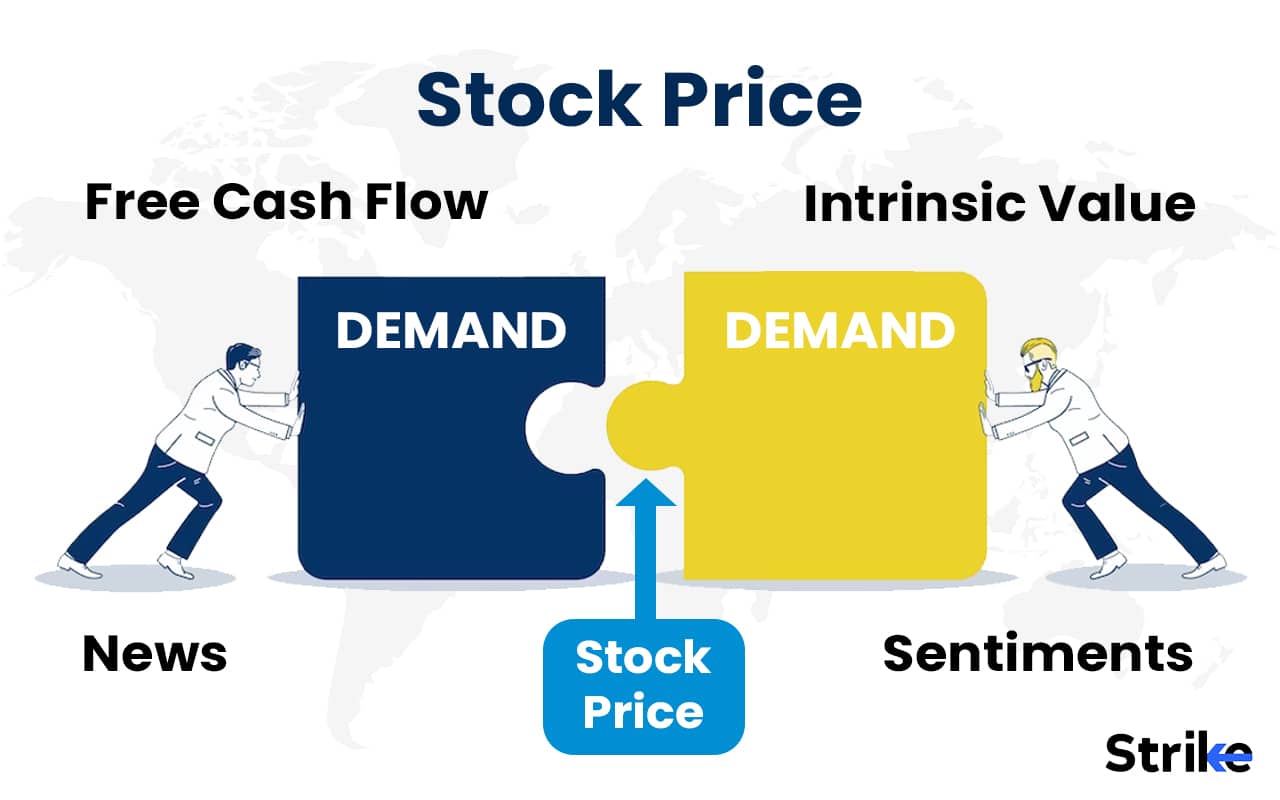How Stock Prices are Determined?

The stock price of a company is one of the most important determinants for traders when trading. The stock price of a company means the current price of the company’s shares.
The stock prices of a company are determined primarily through supply and demand. Increased supply means lesser demand and vice versa. More number of investors buying a stock will rile up its prices. Factors like industry trends, economic factors, news, and earnings also play a role in determining stock prices.
What actually is the price of a stock?
The stock price is simply the price at which the stock is trading in the market right now. The stock price is determined by the laws of supply and demand primarily. The stock price fluctuates throughout the day as buyers and sellers place trades, reacting to news events, earnings reports, and other factors that influence perceptions of the stock’s value.
What determines a stock price?
The price of a stock is ultimately determined by the laws of supply and demand in the stock market. There are more buyers for a stock than sellers means the price will tend to rise. There are more sellers than buyers means the price will tend to fall. The interaction between buyers and sellers as they place orders sets the current market price.
This supply and demand is reflected in the bid and ask prices for a stock. The bid price is the highest price a buyer is willing to pay for the stock. The ask price is the lowest price a seller is willing to accept. The difference between these is called the bid-ask spread. When the spread is wide, it indicates an illiquid market where buyers and sellers are having difficulty agreeing on a price. When the spread is narrow, it signals a liquid market.
For example, consider shares of Reliance Industries (RIL) trading at ₹2,000 per share. The bid price may be ₹1,990 for 100 shares while the ask price is ₹2,010 for 100 shares. If you place a buy order, you pay the ask price of ₹2,010 per share. If you place a sell order, you receive the bid price of ₹1,990 per share. As buying and selling continues, the changing transaction prices determine the stock’s market price. In this way, the relative balance of supply and demand determines RIL’s share price. If more investors want to buy the stock, they will compete and bid the price up. If more want to sell, the ask price will fall as sellers undercut each other. The company’s performance and news also influence this dynamic by affecting investor demand.
How price of stock is calculated?
The price of a stock is calculated by the market forces of supply and demand – the more buyers for a stock compared to sellers, the higher the price will be set, while more sellers compared to buyers will lead to a lower price.
Why do stock prices change every second?
Stock prices change every second because they are constantly reacting to the dynamic forces of supply and demand in the market – when an order is placed to buy or sell a stock, it shifts the balance between supply and demand, causing the price to adjust accordingly. The prevalence of high-frequency trading algorithms and the continuous stream of new information in today’s markets also lead to constant price fluctuations on a second-by-second basis.
What factors affect the share prices of a company?
The main factors that affect the share price of a company are supply & demand, industry trends, economic factors. news and earnings.
Supply and demand
The most basic factor determining a stock’s price is supply and demand. The share price will rise when there are more buyers interested in purchasing a stock than sellers offering it. The price will fall if sellers outnumber buyers. The interaction between buyers and sellers as market orders are placed drives the price up or down to reach an equilibrium price.
Industry Trends
Stocks of companies in a particular industry will often move together based on the performance of that sector as a whole. When an industry is doing well and growing profits, stock prices in that sector will generally rise. If an industry is declining or facing headwinds, stock prices of companies in that industry will often decline as well.
Economic Factors
The overall state of the economy influences the broad stock market and individual companies. In times of economic growth, stock prices tend to rise while recessions lead to declining prices. Key economic factors like interest rates, inflation, and employment levels impact corporate profits and investor sentiment.
News
New developments regarding a company, such as product launches, mergers, lawsuits, or management changes, can impact its stock price.
Earnings
Quarterly financial results and earnings reports also significantly influence a company’s share price if the figures come in above or below expectations.
Investors need to take care of and understand these factors to make sure their investment decisions are fundamentally sound.









 Previous Article
Previous Article






No Comments Yet